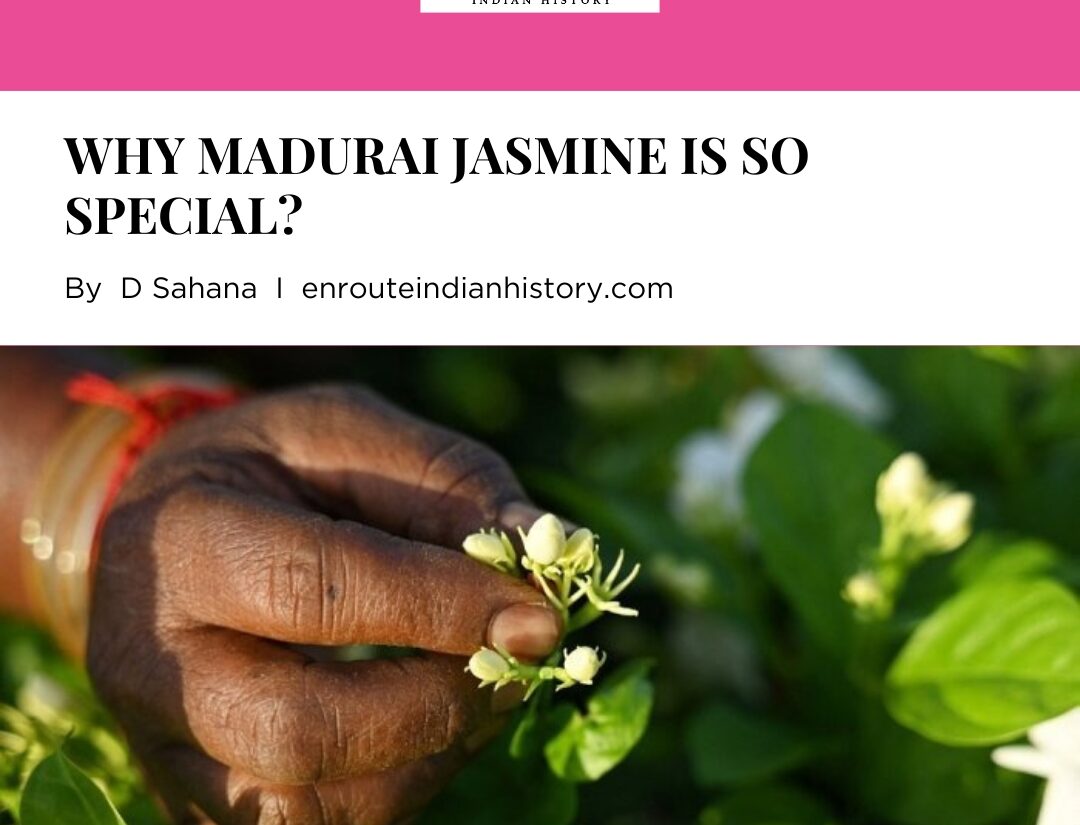
Perfumery is the art or the business of making or selling perfume, and jasmine is one of the most crucial flower scents in the perfume industry. However, extracting perfume oil from the flower is a long and laborious task. Most jasmine production happens in India, especially in the southern Indian city of Madurai. This article will focus on Madurai Jasmine (Malligai), the humble white flower with a sweet scent, and how global perfumery and jasmine are interconnected. The article also looks at the long process of picking jasmine buds to extract fragrance and shipping them to luxury perfume makers in Paris.

Picking of jasmine buds (source: https://www. premiumbeautynews.com/en/scent-of-luxury-in-india-madurai-s,22451)
Madurai Jasmine
Perfumes, or even the art of perfumery, were not just present for people to smell good; they also came from the desire to maintain a good body. The desire to smell good and the art of making scented perfumes and oils have been present in various cultures for a long time, and India is no stranger to this form. One can see several mentions of scented oils or perfumes, such as sandalwood, jasmine, etc., in various ancient Indian texts. Regarding the history of Madurai Jasmine, Madurai is an ancient city in Tamil Nadu, India. The city is also called “Thoonga Nagaram” or the “city that never sleeps”. This city has many beautiful temples, the most prominent being the Arulmigu Meenakshi Sundareswarar Temple. Jasmine, as a flower, is important not just for its scent but also for its religious and cultural significance. Jasmine flowers are offered to the gods and goddesses. These flowers are also made into garlands for offering to gods and wearing on hair.
FINDING THE RIGHT JASMINE
When it comes to perfumery, not all varieties of jasmine are used. Jasminum sambac and Jasminum grandiflorum are the two most widely used varieties of jasmine used in perfume making. In Madurai, Jasminum sambac is extensively grown; it was also given a “geographical indication” tag from India in 2013. As this Madurai Malligai was noted for its “deep fragrance”.

Jasmine sambac, native to Asia (source: Elavarasi- Wiki Commons: https://commons.wikimedia.org/w/index.php?curid=119235602)
But how do the jasmine flowers turn into jasmine oil? It is a labour-intensive and time-consuming task. Be it for worship, perfume making, a wedding or any event; jasmine flowers have to be plucked at the crack of dawn, infact, they have to be handpicked and plucked before they bloom as flowers, as flowers do not retain their fragrance for a long time, hence finding the right bud is essential. This right bud is oblong shaped, with a small white sack-looking bud holding the fragrance and the petals and a small light green stem.
Hence, people pluck the jasmine buds, move the branches of the bushes, and look for this perfect bud. When it comes to keeping the flowers, the pickers tend to put them in their saris instead of jute bags as they are delicate and can get damaged; this is done at least when the buds are being plucked.

Jasminum grandiflorum, native to Asia (source: Juan Carlos Fonseca Mata-Wiki Commons: https://commons.wikimedia.org/w/index.php?curid=110998479)
MAKING JASMINE OIL
After collecting the buds and sending them for refinement, factories wait for the flowers to bloom to start the next step, extracting oil from the jasmine flowers. To understand the scale of how many flowers are needed to make jasmine oil, this figure of reference is helpful: one needs approx 1,000 kg of flowers to extract 1kg of jasmine oil.
After the jasmine flowers start blooming, they are taken to the extractors.
In a video by Business Insider, they explained that jasmine contains indole, which, if present in small amounts, as is the case with jasmine, brings a pleasant aroma.
When processing, the flowers are soaked in a solvent; once the solvent absorbs the smell, the liquid is removed, creating a substance called “concrete”, which is waxy and hard in texture. Then alcohol is added, and concrete is separated from the waxes and filtered, resulting in “absolute”. This absolute is what many perfume makers use for their perfumes. Raja Palaniswamy, who is the Director of Jasmine Concrete Exports Private Limited, told Business Insider that “the range in which the jasmine concrete and absolute is sold is dependent on the flower cost of the year and hence, concrete can be sold for between $2750- $3000, and absolute can go around $5500 or more for per kg cost.

Jasmine sambac concrete (source: https://www.indiamart.com/proddetail/jasmine-sambac-concrete-20934029430.html)
JASMINE IN LUXURY PERFUMES
Jasmine has most of the luxury perfume makers as its clientele. Many perfume houses, such as Dior, Gucci, Burberry, Tom Ford, etc., have Indian jasmine in their perfumes. However, the most prominent was Dior’s J’adore perfume range. In Dior J’adore, jasmine sambac is one of the critical ingredients apart from ylang-ylang, damascena rose and Grasse jasmine. J’adore is also one of the best-selling perfumes by the House of Dior; infact, J’adore perfume is available in different versions as well, such as J’adore L’Absolu, J’adore L’Or and J’adore Eau de Toilette. It is also available as body cream and gel (J’adore Les Adorables range).

Dior J’adore Eau de parfum (source: https://www.dior.com/en_int/beauty/products/jadore-Y0715201.html)
Jasmine is one of the most highly sought-after ingredients in the perfume industry; its sweet scent has captured people’s hearts; however, the whole process of procuring a jasmine scent is long and laborious. However, one must note how fascinating the journey of the flower is, from its use in rituals to becoming a star ingredient in many luxury perfumes, from jasmine production in Madurai to jasmine extract in Paris.
REFERENCES:
Afp (2023) ‘How an Indian flower is giving a rich scent to global luxury perfumes,’ Mintlounge, 16 August. https://lifestyle.livemint.com/fashion/beauty/jasmine-madurai-flower-dior-guerlain-111692180772123.html.
Business Insider India (2022) Why jasmine oil is so expensive | So expensive. https://www.youtube.com/watch?v=-fNlkp-pSxo.
Doe, J. Madurai | Cities of Tamil Nadu | Tamil Nadu Tourism. https://www.tamilnadutourism.tn.gov.in/destinations/madurai.
Gupta, S. (2023) Used in luxurious French perfumes, what makes Madurai’s jasmine oil so expensive? https://thebetterindia.com/311983/why-is-jasmine-oil-from-madurai-so-expensive-to-make-used-in-french-perfumes-video/#google_vignette.
Menon, P.M. (2012) ‘The secret of Dior fragrances: Madurai malli,’ The Times of India, 5 October. https://timesofindia.indiatimes.com/city/chennai/the-secret-of-dior-fragrances-madurai-malli/articleshow/16678195.cms.
https://www.dior.com/en_int/beauty/products/jadore-Y0715201.html
- Global perfumery and jasmine
- History of Madurai jasmine
- Indian jasmine in perfumes
- Indian jasmine perfume trade
- Jasmine cultivation in Madurai
- Jasmine essence in global markets
- Jasmine flower perfume production
- Jasmine production in Madurai
- Jasmine scent in perfumery
- Jasmine trade in India
- Madurai jasmine exports
- Madurai jasmine perfume
- Madurai Malligai fragrance
- Perfumery industry and jasmine
- Traditional jasmine perfume making




















